Leadership Challenges: A Deep Dive into Modern Organizational Issues
VerifiedAdded on 2022/12/23
|10
|3533
|1
Essay
AI Summary
This essay delves into the significant challenges confronting leaders in contemporary organizations. It identifies key issues, including developing managerial effectiveness, such as time management, prioritization, strategic thinking, and decision-making, and the crucial task of employee development through mentoring, coaching, and addressing diverse learning needs. The essay also examines external and internal challenges leaders face, emphasizing the need for adaptability, strategic planning, and effective communication. It provides recommendations for leadership development, including goal-setting, delegation, fostering strong networks, and engaging employees through tailored training programs and meeting their psychological and social needs. The essay emphasizes the importance of adapting to a complex and evolving business environment, making this a valuable resource for students studying leadership and management on Desklib.
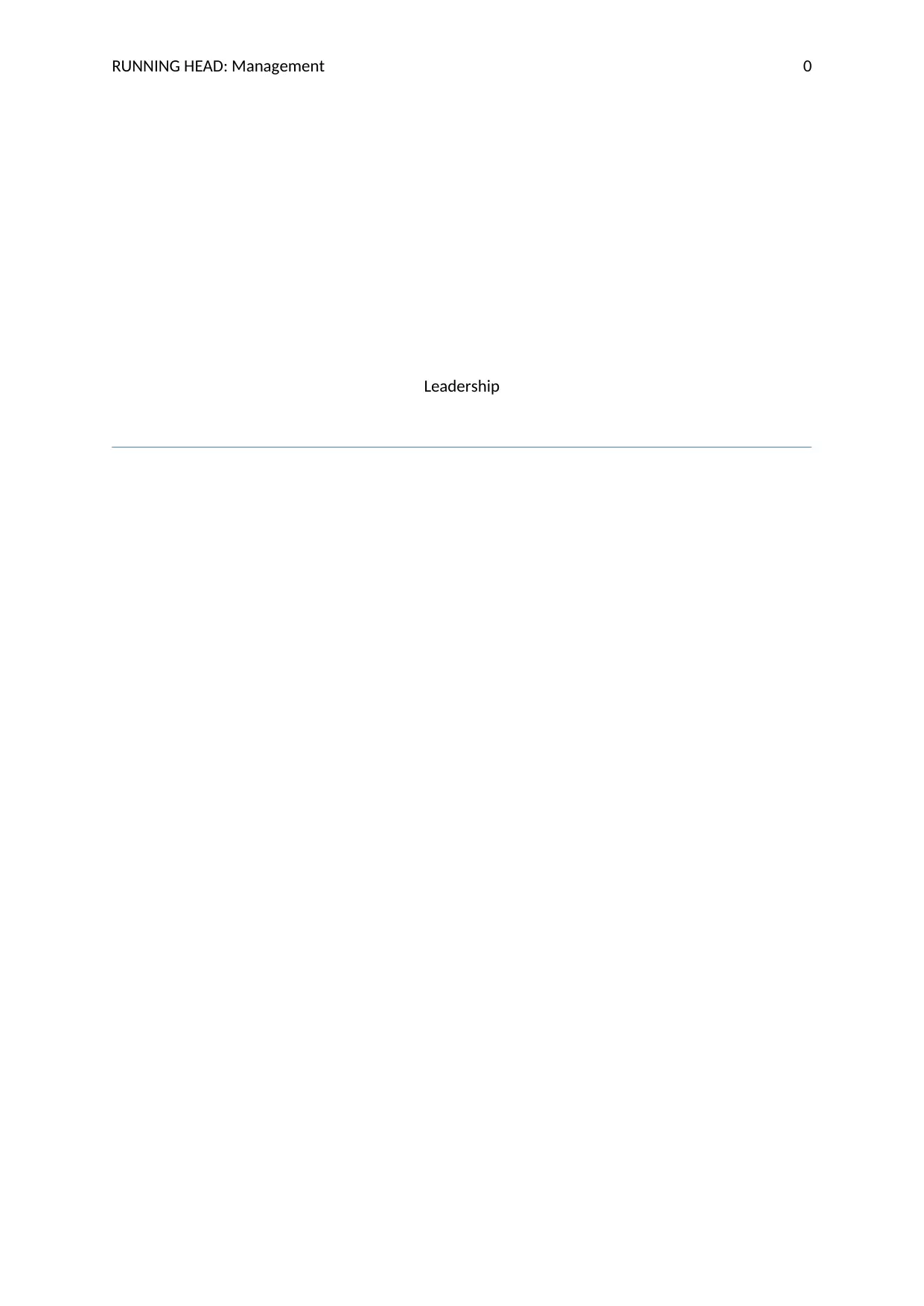
RUNNING HEAD: Management 0
Leadership
Leadership
Paraphrase This Document
Need a fresh take? Get an instant paraphrase of this document with our AI Paraphraser
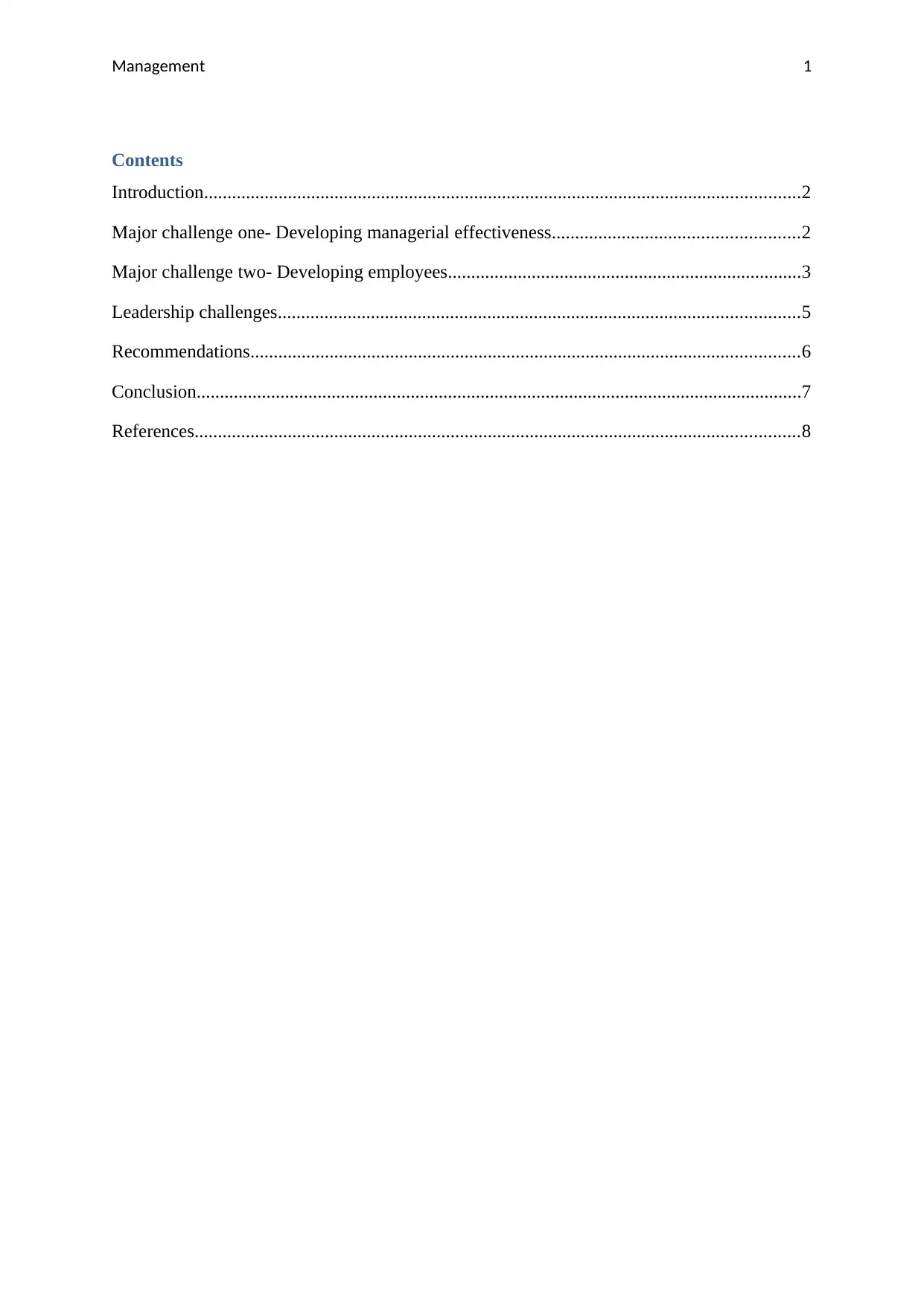
Management 1
Contents
Introduction................................................................................................................................2
Major challenge one- Developing managerial effectiveness.....................................................2
Major challenge two- Developing employees............................................................................3
Leadership challenges................................................................................................................5
Recommendations......................................................................................................................6
Conclusion..................................................................................................................................7
References..................................................................................................................................8
Contents
Introduction................................................................................................................................2
Major challenge one- Developing managerial effectiveness.....................................................2
Major challenge two- Developing employees............................................................................3
Leadership challenges................................................................................................................5
Recommendations......................................................................................................................6
Conclusion..................................................................................................................................7
References..................................................................................................................................8
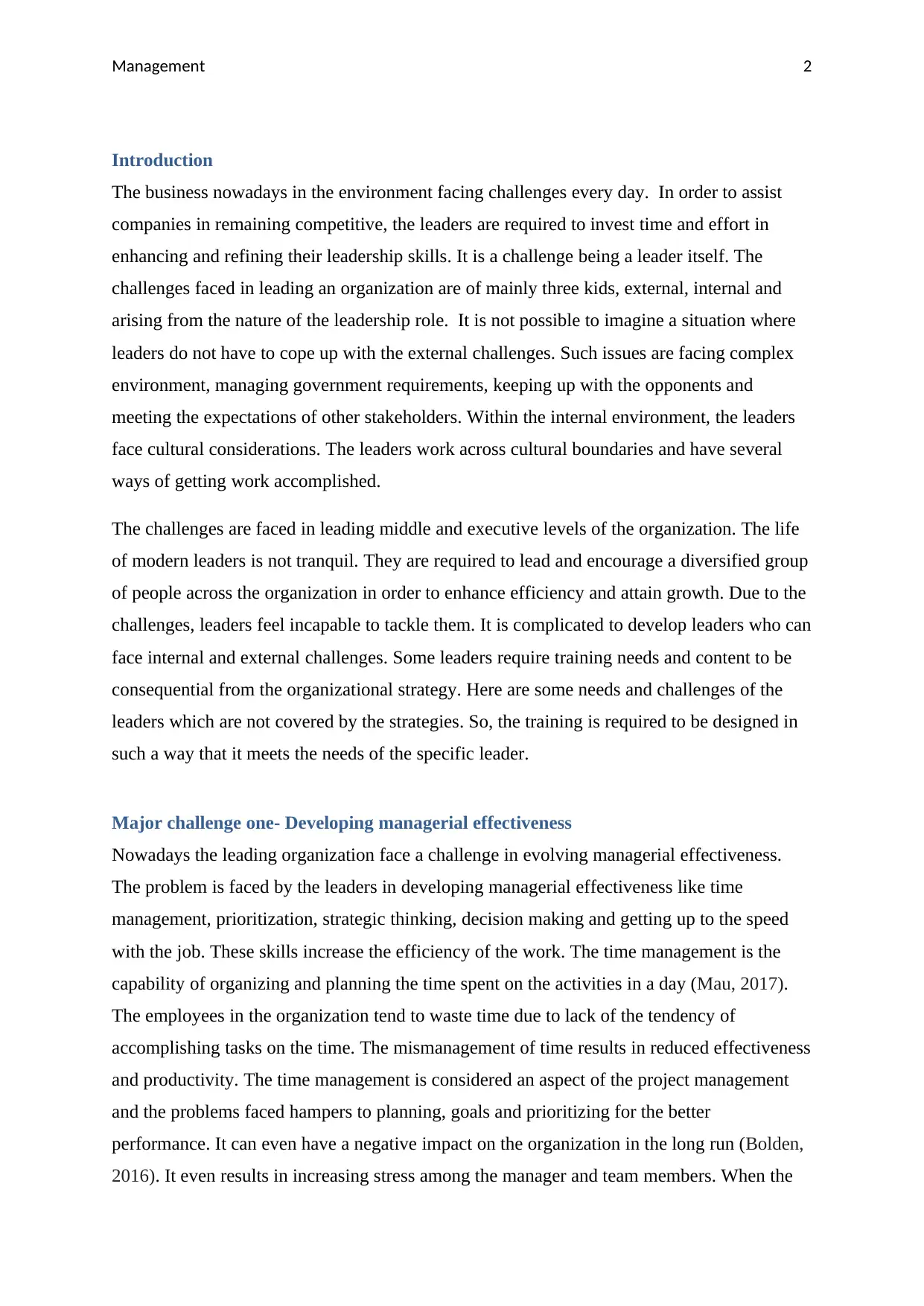
Management 2
Introduction
The business nowadays in the environment facing challenges every day. In order to assist
companies in remaining competitive, the leaders are required to invest time and effort in
enhancing and refining their leadership skills. It is a challenge being a leader itself. The
challenges faced in leading an organization are of mainly three kids, external, internal and
arising from the nature of the leadership role. It is not possible to imagine a situation where
leaders do not have to cope up with the external challenges. Such issues are facing complex
environment, managing government requirements, keeping up with the opponents and
meeting the expectations of other stakeholders. Within the internal environment, the leaders
face cultural considerations. The leaders work across cultural boundaries and have several
ways of getting work accomplished.
The challenges are faced in leading middle and executive levels of the organization. The life
of modern leaders is not tranquil. They are required to lead and encourage a diversified group
of people across the organization in order to enhance efficiency and attain growth. Due to the
challenges, leaders feel incapable to tackle them. It is complicated to develop leaders who can
face internal and external challenges. Some leaders require training needs and content to be
consequential from the organizational strategy. Here are some needs and challenges of the
leaders which are not covered by the strategies. So, the training is required to be designed in
such a way that it meets the needs of the specific leader.
Major challenge one- Developing managerial effectiveness
Nowadays the leading organization face a challenge in evolving managerial effectiveness.
The problem is faced by the leaders in developing managerial effectiveness like time
management, prioritization, strategic thinking, decision making and getting up to the speed
with the job. These skills increase the efficiency of the work. The time management is the
capability of organizing and planning the time spent on the activities in a day (Mau, 2017).
The employees in the organization tend to waste time due to lack of the tendency of
accomplishing tasks on the time. The mismanagement of time results in reduced effectiveness
and productivity. The time management is considered an aspect of the project management
and the problems faced hampers to planning, goals and prioritizing for the better
performance. It can even have a negative impact on the organization in the long run (Bolden,
2016). It even results in increasing stress among the manager and team members. When the
Introduction
The business nowadays in the environment facing challenges every day. In order to assist
companies in remaining competitive, the leaders are required to invest time and effort in
enhancing and refining their leadership skills. It is a challenge being a leader itself. The
challenges faced in leading an organization are of mainly three kids, external, internal and
arising from the nature of the leadership role. It is not possible to imagine a situation where
leaders do not have to cope up with the external challenges. Such issues are facing complex
environment, managing government requirements, keeping up with the opponents and
meeting the expectations of other stakeholders. Within the internal environment, the leaders
face cultural considerations. The leaders work across cultural boundaries and have several
ways of getting work accomplished.
The challenges are faced in leading middle and executive levels of the organization. The life
of modern leaders is not tranquil. They are required to lead and encourage a diversified group
of people across the organization in order to enhance efficiency and attain growth. Due to the
challenges, leaders feel incapable to tackle them. It is complicated to develop leaders who can
face internal and external challenges. Some leaders require training needs and content to be
consequential from the organizational strategy. Here are some needs and challenges of the
leaders which are not covered by the strategies. So, the training is required to be designed in
such a way that it meets the needs of the specific leader.
Major challenge one- Developing managerial effectiveness
Nowadays the leading organization face a challenge in evolving managerial effectiveness.
The problem is faced by the leaders in developing managerial effectiveness like time
management, prioritization, strategic thinking, decision making and getting up to the speed
with the job. These skills increase the efficiency of the work. The time management is the
capability of organizing and planning the time spent on the activities in a day (Mau, 2017).
The employees in the organization tend to waste time due to lack of the tendency of
accomplishing tasks on the time. The mismanagement of time results in reduced effectiveness
and productivity. The time management is considered an aspect of the project management
and the problems faced hampers to planning, goals and prioritizing for the better
performance. It can even have a negative impact on the organization in the long run (Bolden,
2016). It even results in increasing stress among the manager and team members. When the
⊘ This is a preview!⊘
Do you want full access?
Subscribe today to unlock all pages.

Trusted by 1+ million students worldwide
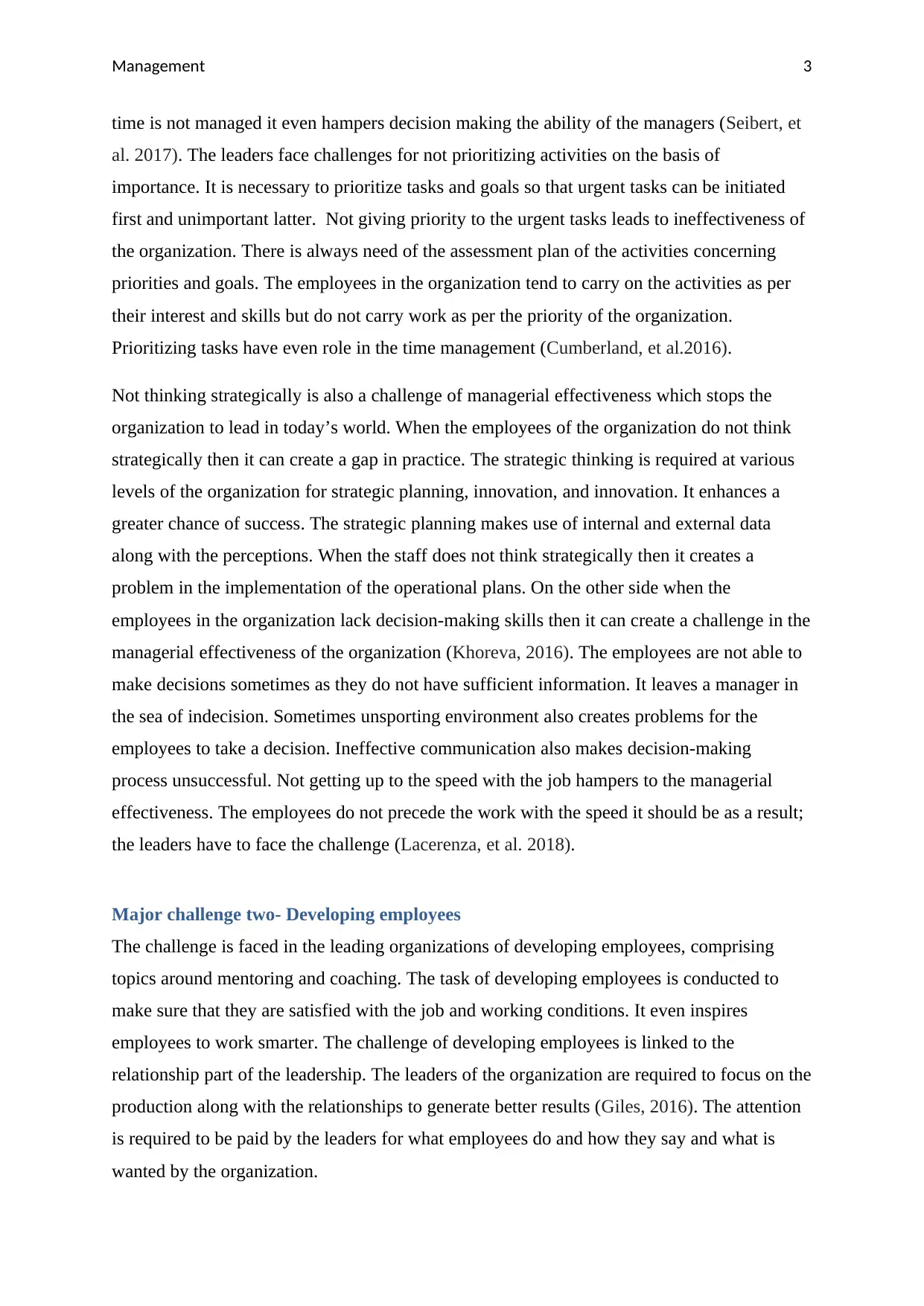
Management 3
time is not managed it even hampers decision making the ability of the managers (Seibert, et
al. 2017). The leaders face challenges for not prioritizing activities on the basis of
importance. It is necessary to prioritize tasks and goals so that urgent tasks can be initiated
first and unimportant latter. Not giving priority to the urgent tasks leads to ineffectiveness of
the organization. There is always need of the assessment plan of the activities concerning
priorities and goals. The employees in the organization tend to carry on the activities as per
their interest and skills but do not carry work as per the priority of the organization.
Prioritizing tasks have even role in the time management (Cumberland, et al.2016).
Not thinking strategically is also a challenge of managerial effectiveness which stops the
organization to lead in today’s world. When the employees of the organization do not think
strategically then it can create a gap in practice. The strategic thinking is required at various
levels of the organization for strategic planning, innovation, and innovation. It enhances a
greater chance of success. The strategic planning makes use of internal and external data
along with the perceptions. When the staff does not think strategically then it creates a
problem in the implementation of the operational plans. On the other side when the
employees in the organization lack decision-making skills then it can create a challenge in the
managerial effectiveness of the organization (Khoreva, 2016). The employees are not able to
make decisions sometimes as they do not have sufficient information. It leaves a manager in
the sea of indecision. Sometimes unsporting environment also creates problems for the
employees to take a decision. Ineffective communication also makes decision-making
process unsuccessful. Not getting up to the speed with the job hampers to the managerial
effectiveness. The employees do not precede the work with the speed it should be as a result;
the leaders have to face the challenge (Lacerenza, et al. 2018).
Major challenge two- Developing employees
The challenge is faced in the leading organizations of developing employees, comprising
topics around mentoring and coaching. The task of developing employees is conducted to
make sure that they are satisfied with the job and working conditions. It even inspires
employees to work smarter. The challenge of developing employees is linked to the
relationship part of the leadership. The leaders of the organization are required to focus on the
production along with the relationships to generate better results (Giles, 2016). The attention
is required to be paid by the leaders for what employees do and how they say and what is
wanted by the organization.
time is not managed it even hampers decision making the ability of the managers (Seibert, et
al. 2017). The leaders face challenges for not prioritizing activities on the basis of
importance. It is necessary to prioritize tasks and goals so that urgent tasks can be initiated
first and unimportant latter. Not giving priority to the urgent tasks leads to ineffectiveness of
the organization. There is always need of the assessment plan of the activities concerning
priorities and goals. The employees in the organization tend to carry on the activities as per
their interest and skills but do not carry work as per the priority of the organization.
Prioritizing tasks have even role in the time management (Cumberland, et al.2016).
Not thinking strategically is also a challenge of managerial effectiveness which stops the
organization to lead in today’s world. When the employees of the organization do not think
strategically then it can create a gap in practice. The strategic thinking is required at various
levels of the organization for strategic planning, innovation, and innovation. It enhances a
greater chance of success. The strategic planning makes use of internal and external data
along with the perceptions. When the staff does not think strategically then it creates a
problem in the implementation of the operational plans. On the other side when the
employees in the organization lack decision-making skills then it can create a challenge in the
managerial effectiveness of the organization (Khoreva, 2016). The employees are not able to
make decisions sometimes as they do not have sufficient information. It leaves a manager in
the sea of indecision. Sometimes unsporting environment also creates problems for the
employees to take a decision. Ineffective communication also makes decision-making
process unsuccessful. Not getting up to the speed with the job hampers to the managerial
effectiveness. The employees do not precede the work with the speed it should be as a result;
the leaders have to face the challenge (Lacerenza, et al. 2018).
Major challenge two- Developing employees
The challenge is faced in the leading organizations of developing employees, comprising
topics around mentoring and coaching. The task of developing employees is conducted to
make sure that they are satisfied with the job and working conditions. It even inspires
employees to work smarter. The challenge of developing employees is linked to the
relationship part of the leadership. The leaders of the organization are required to focus on the
production along with the relationships to generate better results (Giles, 2016). The attention
is required to be paid by the leaders for what employees do and how they say and what is
wanted by the organization.
Paraphrase This Document
Need a fresh take? Get an instant paraphrase of this document with our AI Paraphraser
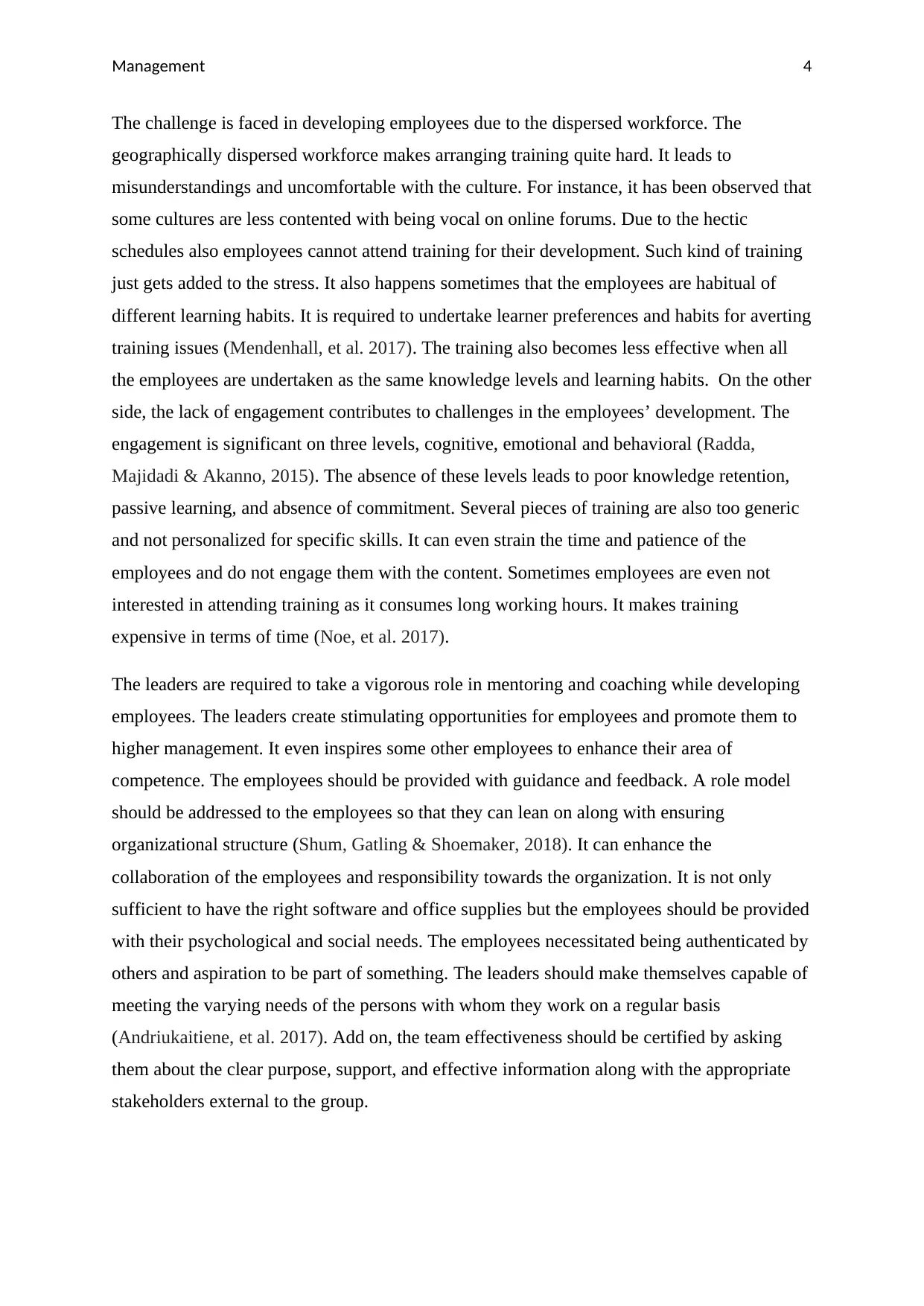
Management 4
The challenge is faced in developing employees due to the dispersed workforce. The
geographically dispersed workforce makes arranging training quite hard. It leads to
misunderstandings and uncomfortable with the culture. For instance, it has been observed that
some cultures are less contented with being vocal on online forums. Due to the hectic
schedules also employees cannot attend training for their development. Such kind of training
just gets added to the stress. It also happens sometimes that the employees are habitual of
different learning habits. It is required to undertake learner preferences and habits for averting
training issues (Mendenhall, et al. 2017). The training also becomes less effective when all
the employees are undertaken as the same knowledge levels and learning habits. On the other
side, the lack of engagement contributes to challenges in the employees’ development. The
engagement is significant on three levels, cognitive, emotional and behavioral (Radda,
Majidadi & Akanno, 2015). The absence of these levels leads to poor knowledge retention,
passive learning, and absence of commitment. Several pieces of training are also too generic
and not personalized for specific skills. It can even strain the time and patience of the
employees and do not engage them with the content. Sometimes employees are even not
interested in attending training as it consumes long working hours. It makes training
expensive in terms of time (Noe, et al. 2017).
The leaders are required to take a vigorous role in mentoring and coaching while developing
employees. The leaders create stimulating opportunities for employees and promote them to
higher management. It even inspires some other employees to enhance their area of
competence. The employees should be provided with guidance and feedback. A role model
should be addressed to the employees so that they can lean on along with ensuring
organizational structure (Shum, Gatling & Shoemaker, 2018). It can enhance the
collaboration of the employees and responsibility towards the organization. It is not only
sufficient to have the right software and office supplies but the employees should be provided
with their psychological and social needs. The employees necessitated being authenticated by
others and aspiration to be part of something. The leaders should make themselves capable of
meeting the varying needs of the persons with whom they work on a regular basis
(Аndriukaitiene, et al. 2017). Add on, the team effectiveness should be certified by asking
them about the clear purpose, support, and effective information along with the appropriate
stakeholders external to the group.
The challenge is faced in developing employees due to the dispersed workforce. The
geographically dispersed workforce makes arranging training quite hard. It leads to
misunderstandings and uncomfortable with the culture. For instance, it has been observed that
some cultures are less contented with being vocal on online forums. Due to the hectic
schedules also employees cannot attend training for their development. Such kind of training
just gets added to the stress. It also happens sometimes that the employees are habitual of
different learning habits. It is required to undertake learner preferences and habits for averting
training issues (Mendenhall, et al. 2017). The training also becomes less effective when all
the employees are undertaken as the same knowledge levels and learning habits. On the other
side, the lack of engagement contributes to challenges in the employees’ development. The
engagement is significant on three levels, cognitive, emotional and behavioral (Radda,
Majidadi & Akanno, 2015). The absence of these levels leads to poor knowledge retention,
passive learning, and absence of commitment. Several pieces of training are also too generic
and not personalized for specific skills. It can even strain the time and patience of the
employees and do not engage them with the content. Sometimes employees are even not
interested in attending training as it consumes long working hours. It makes training
expensive in terms of time (Noe, et al. 2017).
The leaders are required to take a vigorous role in mentoring and coaching while developing
employees. The leaders create stimulating opportunities for employees and promote them to
higher management. It even inspires some other employees to enhance their area of
competence. The employees should be provided with guidance and feedback. A role model
should be addressed to the employees so that they can lean on along with ensuring
organizational structure (Shum, Gatling & Shoemaker, 2018). It can enhance the
collaboration of the employees and responsibility towards the organization. It is not only
sufficient to have the right software and office supplies but the employees should be provided
with their psychological and social needs. The employees necessitated being authenticated by
others and aspiration to be part of something. The leaders should make themselves capable of
meeting the varying needs of the persons with whom they work on a regular basis
(Аndriukaitiene, et al. 2017). Add on, the team effectiveness should be certified by asking
them about the clear purpose, support, and effective information along with the appropriate
stakeholders external to the group.
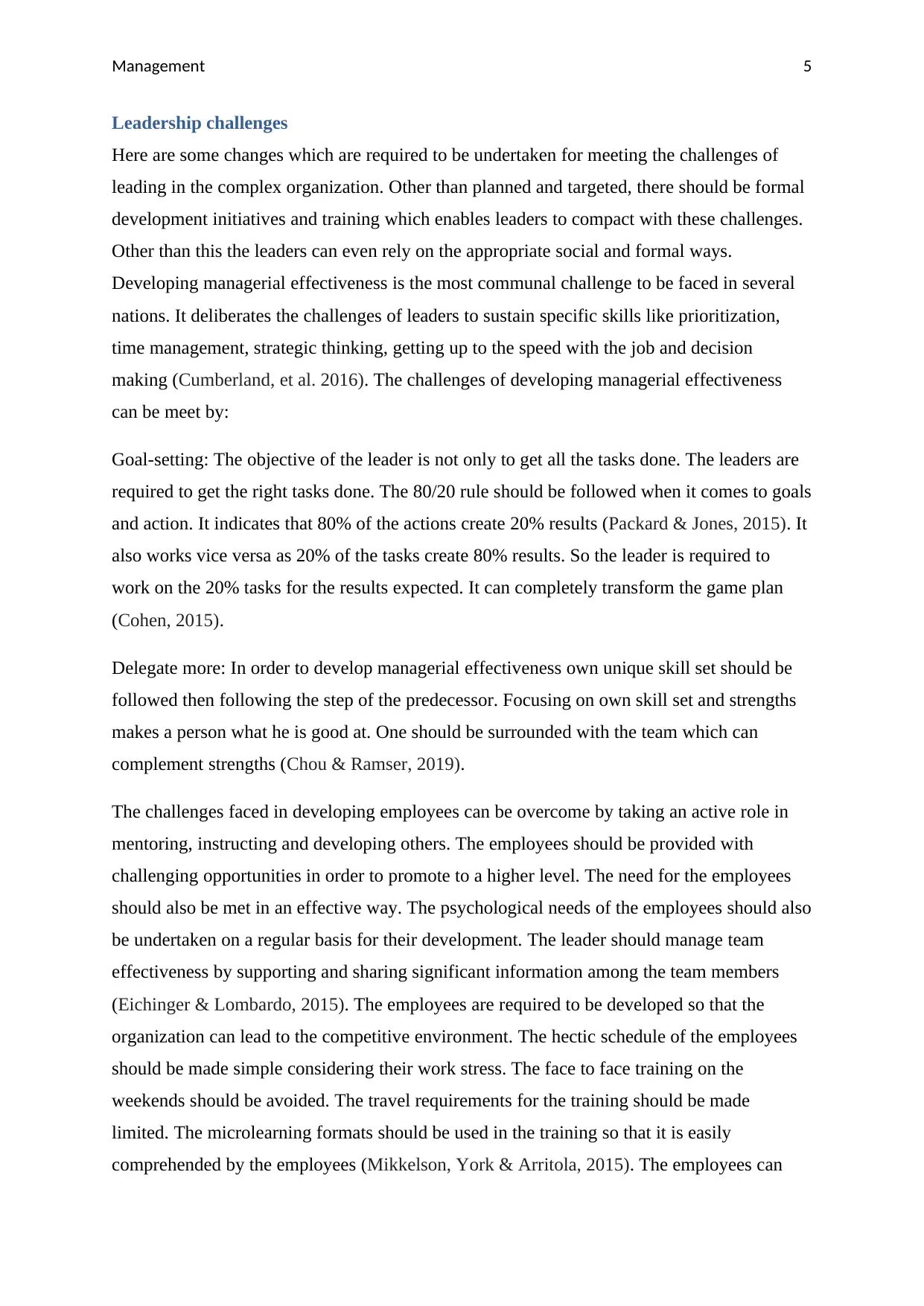
Management 5
Leadership challenges
Here are some changes which are required to be undertaken for meeting the challenges of
leading in the complex organization. Other than planned and targeted, there should be formal
development initiatives and training which enables leaders to compact with these challenges.
Other than this the leaders can even rely on the appropriate social and formal ways.
Developing managerial effectiveness is the most communal challenge to be faced in several
nations. It deliberates the challenges of leaders to sustain specific skills like prioritization,
time management, strategic thinking, getting up to the speed with the job and decision
making (Cumberland, et al. 2016). The challenges of developing managerial effectiveness
can be meet by:
Goal-setting: The objective of the leader is not only to get all the tasks done. The leaders are
required to get the right tasks done. The 80/20 rule should be followed when it comes to goals
and action. It indicates that 80% of the actions create 20% results (Packard & Jones, 2015). It
also works vice versa as 20% of the tasks create 80% results. So the leader is required to
work on the 20% tasks for the results expected. It can completely transform the game plan
(Cohen, 2015).
Delegate more: In order to develop managerial effectiveness own unique skill set should be
followed then following the step of the predecessor. Focusing on own skill set and strengths
makes a person what he is good at. One should be surrounded with the team which can
complement strengths (Chou & Ramser, 2019).
The challenges faced in developing employees can be overcome by taking an active role in
mentoring, instructing and developing others. The employees should be provided with
challenging opportunities in order to promote to a higher level. The need for the employees
should also be met in an effective way. The psychological needs of the employees should also
be undertaken on a regular basis for their development. The leader should manage team
effectiveness by supporting and sharing significant information among the team members
(Eichinger & Lombardo, 2015). The employees are required to be developed so that the
organization can lead to the competitive environment. The hectic schedule of the employees
should be made simple considering their work stress. The face to face training on the
weekends should be avoided. The travel requirements for the training should be made
limited. The microlearning formats should be used in the training so that it is easily
comprehended by the employees (Mikkelson, York & Arritola, 2015). The employees can
Leadership challenges
Here are some changes which are required to be undertaken for meeting the challenges of
leading in the complex organization. Other than planned and targeted, there should be formal
development initiatives and training which enables leaders to compact with these challenges.
Other than this the leaders can even rely on the appropriate social and formal ways.
Developing managerial effectiveness is the most communal challenge to be faced in several
nations. It deliberates the challenges of leaders to sustain specific skills like prioritization,
time management, strategic thinking, getting up to the speed with the job and decision
making (Cumberland, et al. 2016). The challenges of developing managerial effectiveness
can be meet by:
Goal-setting: The objective of the leader is not only to get all the tasks done. The leaders are
required to get the right tasks done. The 80/20 rule should be followed when it comes to goals
and action. It indicates that 80% of the actions create 20% results (Packard & Jones, 2015). It
also works vice versa as 20% of the tasks create 80% results. So the leader is required to
work on the 20% tasks for the results expected. It can completely transform the game plan
(Cohen, 2015).
Delegate more: In order to develop managerial effectiveness own unique skill set should be
followed then following the step of the predecessor. Focusing on own skill set and strengths
makes a person what he is good at. One should be surrounded with the team which can
complement strengths (Chou & Ramser, 2019).
The challenges faced in developing employees can be overcome by taking an active role in
mentoring, instructing and developing others. The employees should be provided with
challenging opportunities in order to promote to a higher level. The need for the employees
should also be met in an effective way. The psychological needs of the employees should also
be undertaken on a regular basis for their development. The leader should manage team
effectiveness by supporting and sharing significant information among the team members
(Eichinger & Lombardo, 2015). The employees are required to be developed so that the
organization can lead to the competitive environment. The hectic schedule of the employees
should be made simple considering their work stress. The face to face training on the
weekends should be avoided. The travel requirements for the training should be made
limited. The microlearning formats should be used in the training so that it is easily
comprehended by the employees (Mikkelson, York & Arritola, 2015). The employees can
⊘ This is a preview!⊘
Do you want full access?
Subscribe today to unlock all pages.

Trusted by 1+ million students worldwide
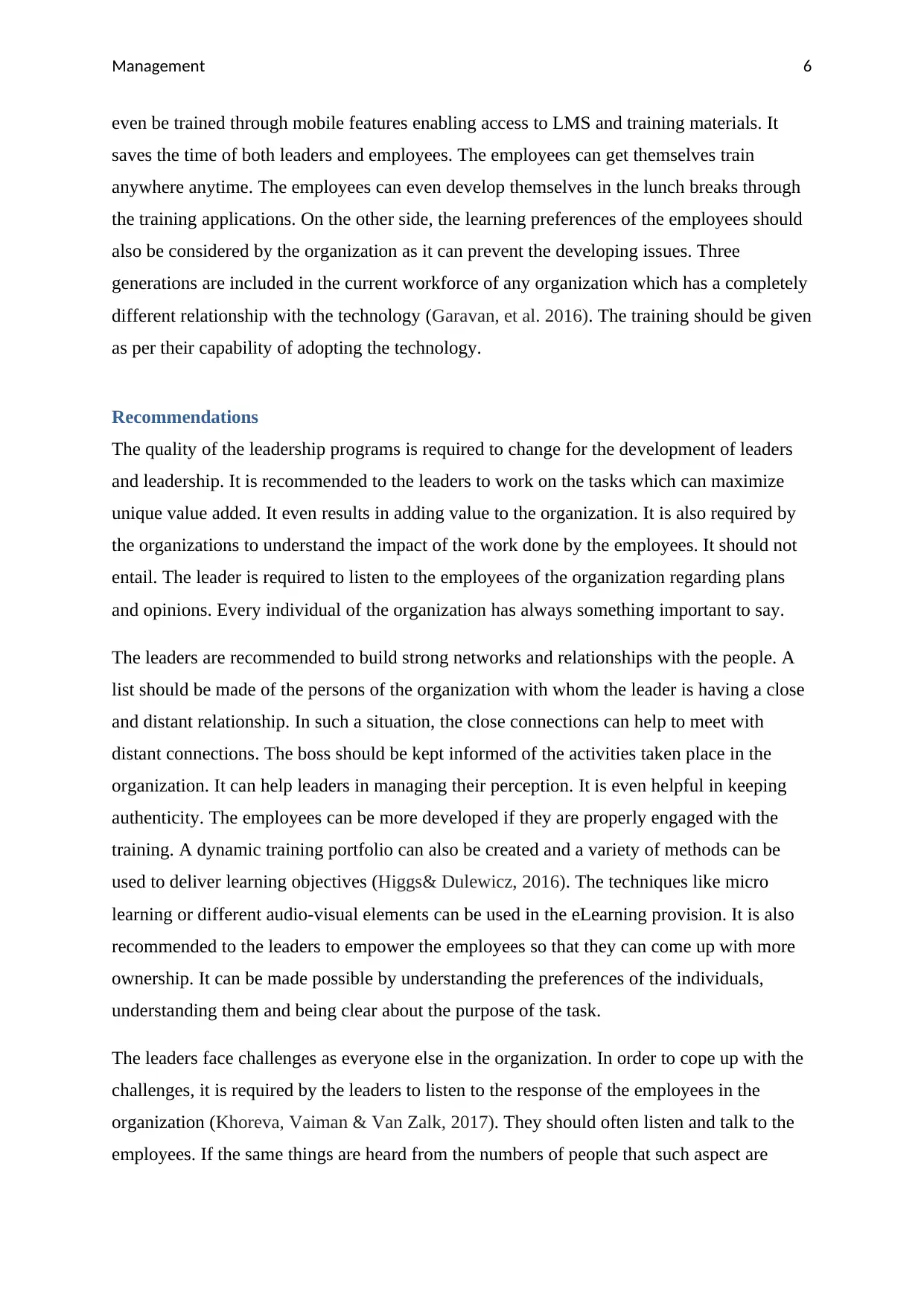
Management 6
even be trained through mobile features enabling access to LMS and training materials. It
saves the time of both leaders and employees. The employees can get themselves train
anywhere anytime. The employees can even develop themselves in the lunch breaks through
the training applications. On the other side, the learning preferences of the employees should
also be considered by the organization as it can prevent the developing issues. Three
generations are included in the current workforce of any organization which has a completely
different relationship with the technology (Garavan, et al. 2016). The training should be given
as per their capability of adopting the technology.
Recommendations
The quality of the leadership programs is required to change for the development of leaders
and leadership. It is recommended to the leaders to work on the tasks which can maximize
unique value added. It even results in adding value to the organization. It is also required by
the organizations to understand the impact of the work done by the employees. It should not
entail. The leader is required to listen to the employees of the organization regarding plans
and opinions. Every individual of the organization has always something important to say.
The leaders are recommended to build strong networks and relationships with the people. A
list should be made of the persons of the organization with whom the leader is having a close
and distant relationship. In such a situation, the close connections can help to meet with
distant connections. The boss should be kept informed of the activities taken place in the
organization. It can help leaders in managing their perception. It is even helpful in keeping
authenticity. The employees can be more developed if they are properly engaged with the
training. A dynamic training portfolio can also be created and a variety of methods can be
used to deliver learning objectives (Higgs& Dulewicz, 2016). The techniques like micro
learning or different audio-visual elements can be used in the eLearning provision. It is also
recommended to the leaders to empower the employees so that they can come up with more
ownership. It can be made possible by understanding the preferences of the individuals,
understanding them and being clear about the purpose of the task.
The leaders face challenges as everyone else in the organization. In order to cope up with the
challenges, it is required by the leaders to listen to the response of the employees in the
organization (Khoreva, Vaiman & Van Zalk, 2017). They should often listen and talk to the
employees. If the same things are heard from the numbers of people that such aspect are
even be trained through mobile features enabling access to LMS and training materials. It
saves the time of both leaders and employees. The employees can get themselves train
anywhere anytime. The employees can even develop themselves in the lunch breaks through
the training applications. On the other side, the learning preferences of the employees should
also be considered by the organization as it can prevent the developing issues. Three
generations are included in the current workforce of any organization which has a completely
different relationship with the technology (Garavan, et al. 2016). The training should be given
as per their capability of adopting the technology.
Recommendations
The quality of the leadership programs is required to change for the development of leaders
and leadership. It is recommended to the leaders to work on the tasks which can maximize
unique value added. It even results in adding value to the organization. It is also required by
the organizations to understand the impact of the work done by the employees. It should not
entail. The leader is required to listen to the employees of the organization regarding plans
and opinions. Every individual of the organization has always something important to say.
The leaders are recommended to build strong networks and relationships with the people. A
list should be made of the persons of the organization with whom the leader is having a close
and distant relationship. In such a situation, the close connections can help to meet with
distant connections. The boss should be kept informed of the activities taken place in the
organization. It can help leaders in managing their perception. It is even helpful in keeping
authenticity. The employees can be more developed if they are properly engaged with the
training. A dynamic training portfolio can also be created and a variety of methods can be
used to deliver learning objectives (Higgs& Dulewicz, 2016). The techniques like micro
learning or different audio-visual elements can be used in the eLearning provision. It is also
recommended to the leaders to empower the employees so that they can come up with more
ownership. It can be made possible by understanding the preferences of the individuals,
understanding them and being clear about the purpose of the task.
The leaders face challenges as everyone else in the organization. In order to cope up with the
challenges, it is required by the leaders to listen to the response of the employees in the
organization (Khoreva, Vaiman & Van Zalk, 2017). They should often listen and talk to the
employees. If the same things are heard from the numbers of people that such aspect are
Paraphrase This Document
Need a fresh take? Get an instant paraphrase of this document with our AI Paraphraser
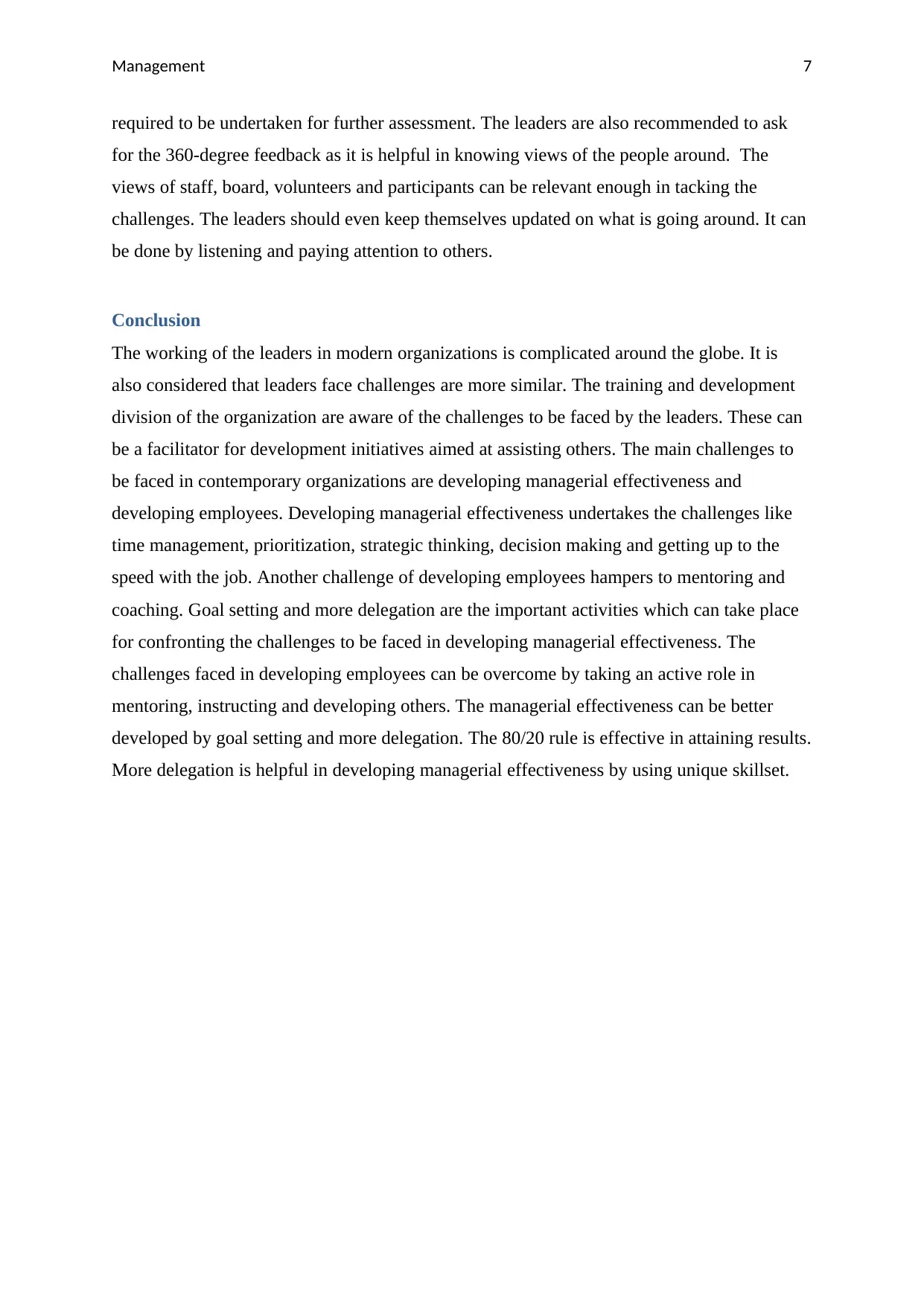
Management 7
required to be undertaken for further assessment. The leaders are also recommended to ask
for the 360-degree feedback as it is helpful in knowing views of the people around. The
views of staff, board, volunteers and participants can be relevant enough in tacking the
challenges. The leaders should even keep themselves updated on what is going around. It can
be done by listening and paying attention to others.
Conclusion
The working of the leaders in modern organizations is complicated around the globe. It is
also considered that leaders face challenges are more similar. The training and development
division of the organization are aware of the challenges to be faced by the leaders. These can
be a facilitator for development initiatives aimed at assisting others. The main challenges to
be faced in contemporary organizations are developing managerial effectiveness and
developing employees. Developing managerial effectiveness undertakes the challenges like
time management, prioritization, strategic thinking, decision making and getting up to the
speed with the job. Another challenge of developing employees hampers to mentoring and
coaching. Goal setting and more delegation are the important activities which can take place
for confronting the challenges to be faced in developing managerial effectiveness. The
challenges faced in developing employees can be overcome by taking an active role in
mentoring, instructing and developing others. The managerial effectiveness can be better
developed by goal setting and more delegation. The 80/20 rule is effective in attaining results.
More delegation is helpful in developing managerial effectiveness by using unique skillset.
required to be undertaken for further assessment. The leaders are also recommended to ask
for the 360-degree feedback as it is helpful in knowing views of the people around. The
views of staff, board, volunteers and participants can be relevant enough in tacking the
challenges. The leaders should even keep themselves updated on what is going around. It can
be done by listening and paying attention to others.
Conclusion
The working of the leaders in modern organizations is complicated around the globe. It is
also considered that leaders face challenges are more similar. The training and development
division of the organization are aware of the challenges to be faced by the leaders. These can
be a facilitator for development initiatives aimed at assisting others. The main challenges to
be faced in contemporary organizations are developing managerial effectiveness and
developing employees. Developing managerial effectiveness undertakes the challenges like
time management, prioritization, strategic thinking, decision making and getting up to the
speed with the job. Another challenge of developing employees hampers to mentoring and
coaching. Goal setting and more delegation are the important activities which can take place
for confronting the challenges to be faced in developing managerial effectiveness. The
challenges faced in developing employees can be overcome by taking an active role in
mentoring, instructing and developing others. The managerial effectiveness can be better
developed by goal setting and more delegation. The 80/20 rule is effective in attaining results.
More delegation is helpful in developing managerial effectiveness by using unique skillset.
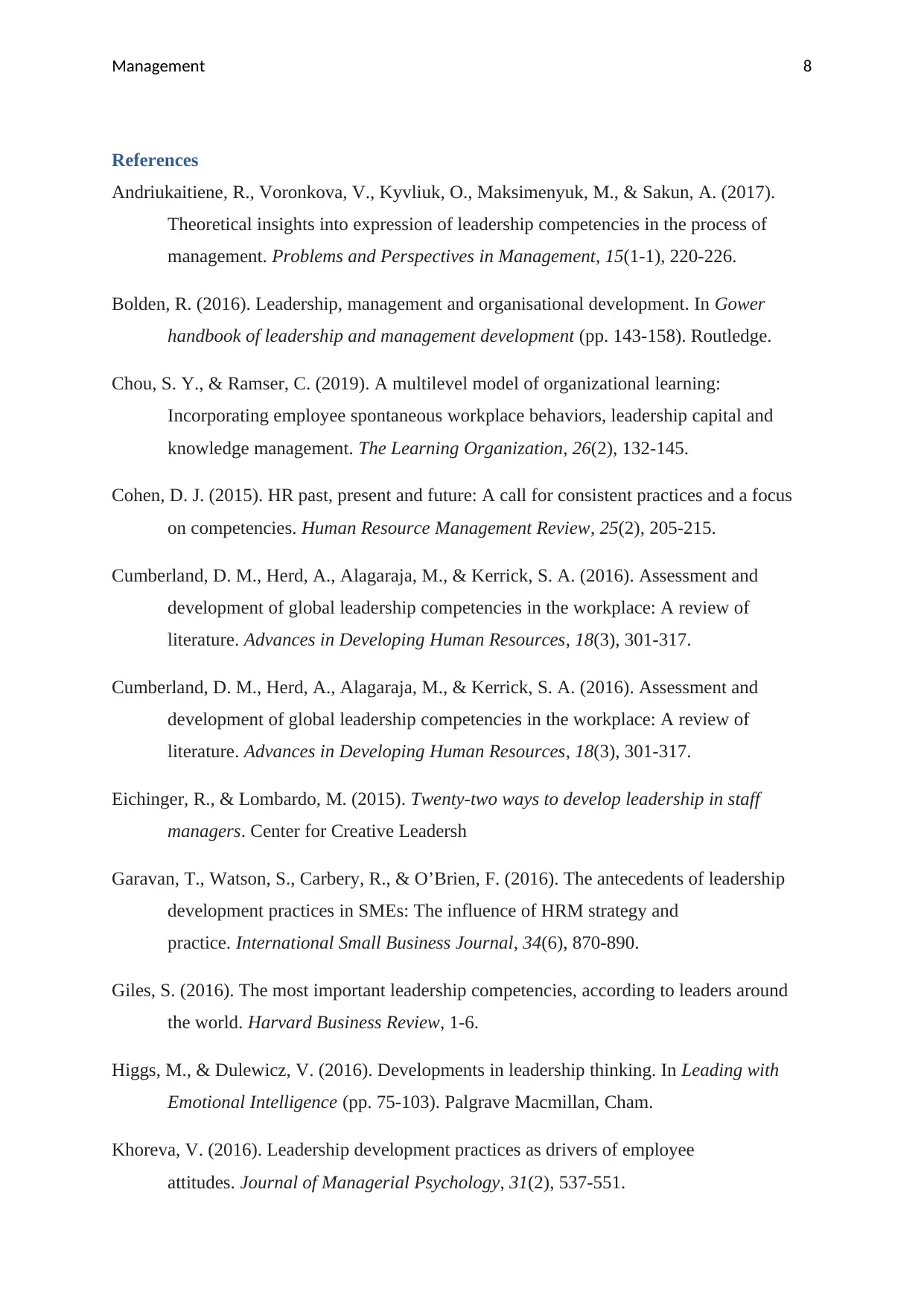
Management 8
References
Аndriukaitiene, R., Voronkova, V., Kyvliuk, O., Maksimenyuk, M., & Sakun, A. (2017).
Theoretical insights into expression of leadership competencies in the process of
management. Problems and Perspectives in Management, 15(1-1), 220-226.
Bolden, R. (2016). Leadership, management and organisational development. In Gower
handbook of leadership and management development (pp. 143-158). Routledge.
Chou, S. Y., & Ramser, C. (2019). A multilevel model of organizational learning:
Incorporating employee spontaneous workplace behaviors, leadership capital and
knowledge management. The Learning Organization, 26(2), 132-145.
Cohen, D. J. (2015). HR past, present and future: A call for consistent practices and a focus
on competencies. Human Resource Management Review, 25(2), 205-215.
Cumberland, D. M., Herd, A., Alagaraja, M., & Kerrick, S. A. (2016). Assessment and
development of global leadership competencies in the workplace: A review of
literature. Advances in Developing Human Resources, 18(3), 301-317.
Cumberland, D. M., Herd, A., Alagaraja, M., & Kerrick, S. A. (2016). Assessment and
development of global leadership competencies in the workplace: A review of
literature. Advances in Developing Human Resources, 18(3), 301-317.
Eichinger, R., & Lombardo, M. (2015). Twenty-two ways to develop leadership in staff
managers. Center for Creative Leadersh
Garavan, T., Watson, S., Carbery, R., & O’Brien, F. (2016). The antecedents of leadership
development practices in SMEs: The influence of HRM strategy and
practice. International Small Business Journal, 34(6), 870-890.
Giles, S. (2016). The most important leadership competencies, according to leaders around
the world. Harvard Business Review, 1-6.
Higgs, M., & Dulewicz, V. (2016). Developments in leadership thinking. In Leading with
Emotional Intelligence (pp. 75-103). Palgrave Macmillan, Cham.
Khoreva, V. (2016). Leadership development practices as drivers of employee
attitudes. Journal of Managerial Psychology, 31(2), 537-551.
References
Аndriukaitiene, R., Voronkova, V., Kyvliuk, O., Maksimenyuk, M., & Sakun, A. (2017).
Theoretical insights into expression of leadership competencies in the process of
management. Problems and Perspectives in Management, 15(1-1), 220-226.
Bolden, R. (2016). Leadership, management and organisational development. In Gower
handbook of leadership and management development (pp. 143-158). Routledge.
Chou, S. Y., & Ramser, C. (2019). A multilevel model of organizational learning:
Incorporating employee spontaneous workplace behaviors, leadership capital and
knowledge management. The Learning Organization, 26(2), 132-145.
Cohen, D. J. (2015). HR past, present and future: A call for consistent practices and a focus
on competencies. Human Resource Management Review, 25(2), 205-215.
Cumberland, D. M., Herd, A., Alagaraja, M., & Kerrick, S. A. (2016). Assessment and
development of global leadership competencies in the workplace: A review of
literature. Advances in Developing Human Resources, 18(3), 301-317.
Cumberland, D. M., Herd, A., Alagaraja, M., & Kerrick, S. A. (2016). Assessment and
development of global leadership competencies in the workplace: A review of
literature. Advances in Developing Human Resources, 18(3), 301-317.
Eichinger, R., & Lombardo, M. (2015). Twenty-two ways to develop leadership in staff
managers. Center for Creative Leadersh
Garavan, T., Watson, S., Carbery, R., & O’Brien, F. (2016). The antecedents of leadership
development practices in SMEs: The influence of HRM strategy and
practice. International Small Business Journal, 34(6), 870-890.
Giles, S. (2016). The most important leadership competencies, according to leaders around
the world. Harvard Business Review, 1-6.
Higgs, M., & Dulewicz, V. (2016). Developments in leadership thinking. In Leading with
Emotional Intelligence (pp. 75-103). Palgrave Macmillan, Cham.
Khoreva, V. (2016). Leadership development practices as drivers of employee
attitudes. Journal of Managerial Psychology, 31(2), 537-551.
⊘ This is a preview!⊘
Do you want full access?
Subscribe today to unlock all pages.

Trusted by 1+ million students worldwide
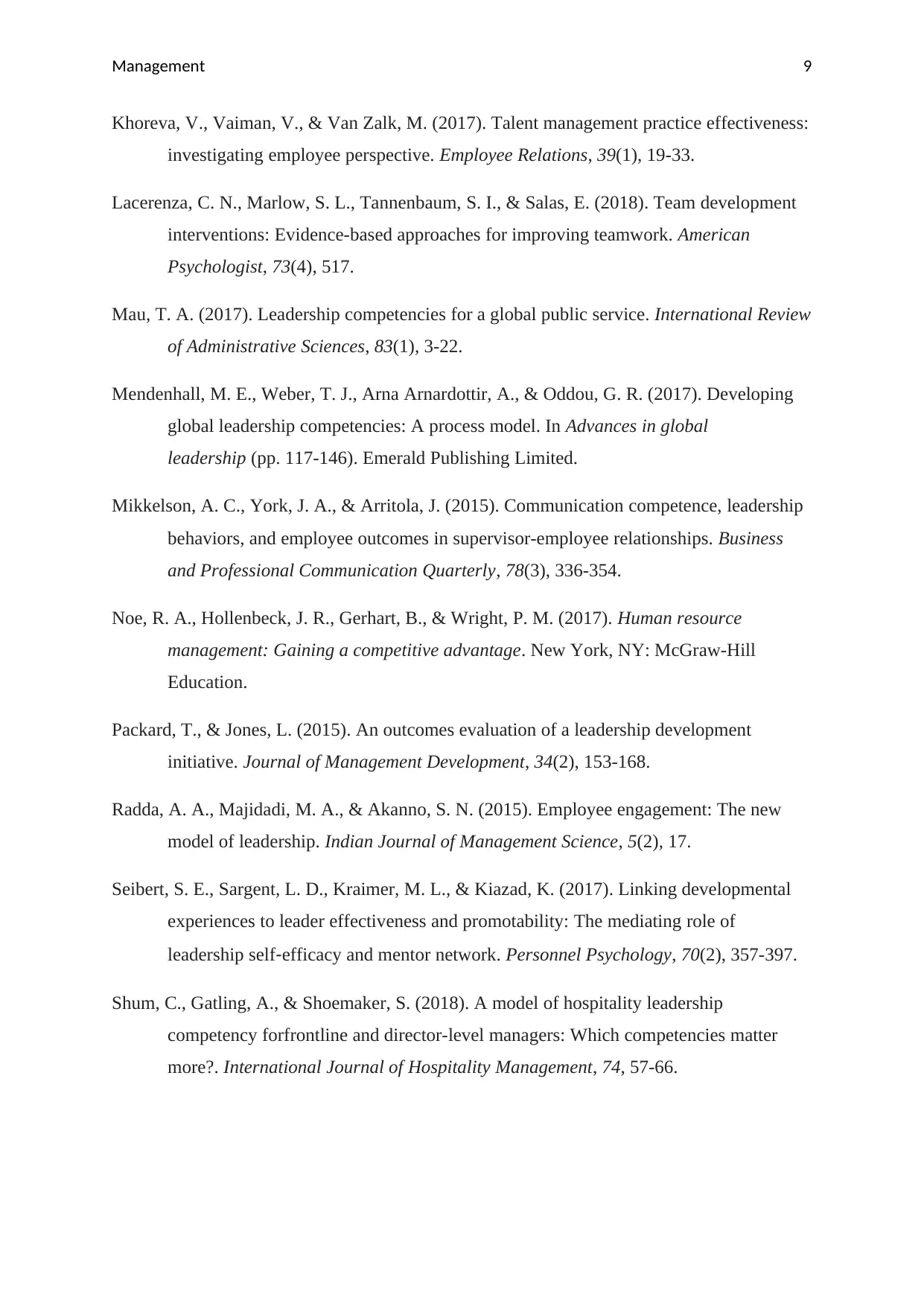
Management 9
Khoreva, V., Vaiman, V., & Van Zalk, M. (2017). Talent management practice effectiveness:
investigating employee perspective. Employee Relations, 39(1), 19-33.
Lacerenza, C. N., Marlow, S. L., Tannenbaum, S. I., & Salas, E. (2018). Team development
interventions: Evidence-based approaches for improving teamwork. American
Psychologist, 73(4), 517.
Mau, T. A. (2017). Leadership competencies for a global public service. International Review
of Administrative Sciences, 83(1), 3-22.
Mendenhall, M. E., Weber, T. J., Arna Arnardottir, A., & Oddou, G. R. (2017). Developing
global leadership competencies: A process model. In Advances in global
leadership (pp. 117-146). Emerald Publishing Limited.
Mikkelson, A. C., York, J. A., & Arritola, J. (2015). Communication competence, leadership
behaviors, and employee outcomes in supervisor-employee relationships. Business
and Professional Communication Quarterly, 78(3), 336-354.
Noe, R. A., Hollenbeck, J. R., Gerhart, B., & Wright, P. M. (2017). Human resource
management: Gaining a competitive advantage. New York, NY: McGraw-Hill
Education.
Packard, T., & Jones, L. (2015). An outcomes evaluation of a leadership development
initiative. Journal of Management Development, 34(2), 153-168.
Radda, A. A., Majidadi, M. A., & Akanno, S. N. (2015). Employee engagement: The new
model of leadership. Indian Journal of Management Science, 5(2), 17.
Seibert, S. E., Sargent, L. D., Kraimer, M. L., & Kiazad, K. (2017). Linking developmental
experiences to leader effectiveness and promotability: The mediating role of
leadership self‐efficacy and mentor network. Personnel Psychology, 70(2), 357-397.
Shum, C., Gatling, A., & Shoemaker, S. (2018). A model of hospitality leadership
competency forfrontline and director-level managers: Which competencies matter
more?. International Journal of Hospitality Management, 74, 57-66.
Khoreva, V., Vaiman, V., & Van Zalk, M. (2017). Talent management practice effectiveness:
investigating employee perspective. Employee Relations, 39(1), 19-33.
Lacerenza, C. N., Marlow, S. L., Tannenbaum, S. I., & Salas, E. (2018). Team development
interventions: Evidence-based approaches for improving teamwork. American
Psychologist, 73(4), 517.
Mau, T. A. (2017). Leadership competencies for a global public service. International Review
of Administrative Sciences, 83(1), 3-22.
Mendenhall, M. E., Weber, T. J., Arna Arnardottir, A., & Oddou, G. R. (2017). Developing
global leadership competencies: A process model. In Advances in global
leadership (pp. 117-146). Emerald Publishing Limited.
Mikkelson, A. C., York, J. A., & Arritola, J. (2015). Communication competence, leadership
behaviors, and employee outcomes in supervisor-employee relationships. Business
and Professional Communication Quarterly, 78(3), 336-354.
Noe, R. A., Hollenbeck, J. R., Gerhart, B., & Wright, P. M. (2017). Human resource
management: Gaining a competitive advantage. New York, NY: McGraw-Hill
Education.
Packard, T., & Jones, L. (2015). An outcomes evaluation of a leadership development
initiative. Journal of Management Development, 34(2), 153-168.
Radda, A. A., Majidadi, M. A., & Akanno, S. N. (2015). Employee engagement: The new
model of leadership. Indian Journal of Management Science, 5(2), 17.
Seibert, S. E., Sargent, L. D., Kraimer, M. L., & Kiazad, K. (2017). Linking developmental
experiences to leader effectiveness and promotability: The mediating role of
leadership self‐efficacy and mentor network. Personnel Psychology, 70(2), 357-397.
Shum, C., Gatling, A., & Shoemaker, S. (2018). A model of hospitality leadership
competency forfrontline and director-level managers: Which competencies matter
more?. International Journal of Hospitality Management, 74, 57-66.
1 out of 10
Related Documents
Your All-in-One AI-Powered Toolkit for Academic Success.
+13062052269
info@desklib.com
Available 24*7 on WhatsApp / Email
![[object Object]](/_next/static/media/star-bottom.7253800d.svg)
Unlock your academic potential
Copyright © 2020–2025 A2Z Services. All Rights Reserved. Developed and managed by ZUCOL.





